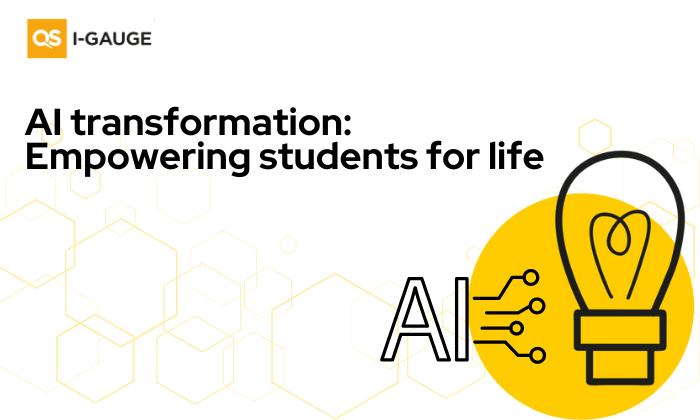
Fostering an atmosphere of innovation and research for students
Creating an atmosphere of innovation and research within the educational environment is a transformative journey that contributes significantly to students’ personal and professional development.
Instilling an innovation and research mindset in students is crucial as it:
- Fosters critical and creative thinking skills
- Prepares students for challenges and cultivates a passion for learning
- Keeps students updated on technological advancements
- Enhances competitiveness and adaptability
- Encourages collaboration, communication, and development of social skills
- Equips students to function effectively in diverse settings, fostering well-rounded individuals ready to contribute positively to society
Here are a few strategies through which educators can help students develop the skills and mindset necessary for success in the dynamic world of innovation and research:
Foster Curiosity: Creating an atmosphere that encourages questioning and curiosity is crucial. Students should feel empowered to explore the "why" and "how" of the world, understanding that curiosity is the spark that ignites innovation.
Encourage Creativity: Stimulating creative thinking by exploring unconventional problem-solving approaches allows students to think outside the box and find innovative solutions to complex challenges.
Inspire Critical Thinking: Educating students on analysing information critically equips them with the tools to navigate a world filled with diverse perspectives. By challenging assumptions and independent thinking, students can develop a deeper understanding of complex issues.
Impart Problem-Solving Skills: Guiding students through open-ended challenges and encouraging brainstorming for diverse solutions builds resilience and adaptability in the realm of innovation.
Cultivate a spirit of exploration: Hands-on activities and experiments offer students a chance to apply theoretical knowledge in practical settings, developing an in-depth understanding of concepts and boosting confidence in their abilities.
Support Collaboration: Creating a collaborative environment where students can exchange ideas and work together to tackle problems promotes teamwork, communication skills, and a diverse range of perspectives.
Acknowledge Failure: By reframing failure as a stepping stone to success, students can develop a growth mindset that embraces challenges and sees setbacks as opportunities for growth and learning.
Provide Mentorship: Offering mentorship opportunities and connecting students with experienced professionals in their field nurtures their passion for innovation and research, providing valuable guidance and insights.
Exposing students to cutting-edge technologies: With the ability to analyse data swiftly and forecast trends, Artificial Intelligence (AI) and Machine Learning (ML) offer students the opportunity to surpass conventional boundaries and unearth deeper insights. Whether students are embarking on innovative projects or delving into intricate theses, these sophisticated technologies serve as catalysts for more extensive explorations. Equipping students with access to such advanced infrastructure not only unlocks a realm of limitless possibilities but also nurtures boundless potential.
Cultivate a mindset of Lifelong Learning: By emphasising the value of continuous growth, students are encouraged to pursue their interests beyond classrooms, fostering a lifelong commitment to learning.
Case Study:
Background: In an effort to cultivate a culture of innovation and research among students, a secondary school in the Pacific Northwest, USA, initiated a comprehensive program designed to embed these skills across the curriculum.
Implementation: The program was structured around three core components: interdisciplinary project-based learning, partnerships with local universities and industries, and a dedicated innovation lab. Teachers collaborated on projects blending various subjects, promoting innovation. For example, a project tasked students with designing sustainable urban transportation solutions, integrating principles from environmental science, technology, engineering, and mathematics (STEM), along with social studies.
Partnerships with local universities and industries not only exposed students to current research methodologies but also allowed them to work alongside professionals and academics, gaining valuable insights and mentorship.
The innovation lab with advanced technologies played a pivotal role in the program by offering students a hub to experiment, prototype, and bring their ideas to life, supported by a team of educators and mentors skilled in guiding innovative projects.
Outcome: The program had a significant impact on students by improving critical thinking, problem-solving skills, and interdisciplinary understanding. Real-world research opportunities enhanced practical skills, competitiveness, and recognition in national competitions. The innovation lab symbolised the school's commitment to fostering creativity and exploration beyond traditional education.
Conclusion: This case study demonstrates how innovative educational programs can improve students' research and problem-solving skills, ignite a love for learning, and bridge disciplinary boundaries to provide real-world research experiences, preparing students for future challenges.
In essence, cultivating an environment that nurtures an inclination towards innovation and research equips students with the necessary skills to excel in a constantly changing global landscape. Fostering traits such as curiosity, critical thinking, and creativity enable students to effectively address intricate challenges, embrace adaptability, and make significant contributions to society.
Disclaimer:
The views and opinions expressed in this blog do not necessarily represent those of QS-ERA India Private Limited and/or its employees, partners, shareholders, or other stakeholders.






Leave Your Comments